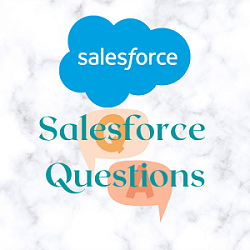1. What is the primary function of large language models in Salesforce?
a) Generating marketing content
b) Predicting customer behavior
c) Optimizing sales strategies
d) Automating customer support
2. Which Salesforce Cloud is most likely to leverage large language models for customer interactions?
a) Sales Cloud
b) Marketing Cloud
c) Service Cloud
d) Commerce Cloud
3. How can large language models enhance Salesforce Einstein AI capabilities?
a) By improving data visualization
b) By providing advanced analytics
c) By enabling natural language processing
d) By enhancing CRM customization options
4. Which aspect of Salesforce marketing campaigns can benefit from large language models?
a) Identifying target audiences
b) Managing customer relationships
c) Analyzing campaign performance
d) Generating personalized content
5. In what way can large language models contribute to Salesforce's predictive analytics capabilities?
a) By identifying sales trends
b) By automating lead scoring
c) By optimizing email campaigns
d) By improving data cleansing processes
6. How do large language models in Salesforce contribute to customer engagement?
a) By automating sales processes
b) By personalizing marketing messages
c) By analyzing competitor strategies
d) By optimizing pricing strategies
7. Which Salesforce feature can be enhanced by integrating large language models for natural language understanding?
a) Chatter
b) Workflow automation
c) Custom report generation
d) Lead assignment rules
8. How can large language models improve Salesforce's ability to handle customer inquiries?
a) By providing real-time sentiment analysis
b) By automating lead generation
c) By optimizing sales forecasts
d) By streamlining account management
9. Which Salesforce product is most likely to incorporate large language models for sentiment analysis?
a) Social Studio
b) Pardot
c) Quip
d) Tableau CRM
10. What potential challenge might arise when implementing large language models in Salesforce?
a) Increased data security risks
b) Decreased scalability
c) Reduced customization options
d) Limited integration capabilities
What does CRM stand for in Salesforce?
a) Customer Relationship Management
b) Customer Resource Management
c) Customer Revenue Management
d) Customer Recognition Management
11. Which Salesforce edition is suitable for small businesses with up to 10 users?
a) Salesforce Essentials
b) Salesforce Professional
c) Salesforce Enterprise
d) Salesforce Unlimited
12. What is the primary purpose of Salesforce Trailhead?
a) To provide customer support
b) To offer product training
c) To deliver marketing campaigns
d) To provide interactive learning and skill development
13. Which Salesforce feature provides predictive analytics and AI-driven insights?
a) Salesforce Lightning
b) Salesforce Einstein
c) Salesforce Automation
d) Salesforce Dashboard
14. Which Salesforce component allows users to automate repetitive tasks?
a) Workflow Rules
b) Validation Rules
c) Sharing Rules
d) Approval Processes
15. What is the primary function of Salesforce AppExchange?
a) To provide customer support services
b) To exchange Salesforce licenses between users
c) To share Salesforce data with external partners
d) To browse and install third-party applications and integrations
16. Which Salesforce feature is used to create custom reports and dashboards?
a) Salesforce Flow
b) Salesforce Process Builder
c) Salesforce Analytics
d) Salesforce Developer Console
17. Which Salesforce tool is used for data import/export and mass updates?
a) Salesforce Data Loader
b) Salesforce Workbench
c) Salesforce Schema Builder
d) Salesforce Query Editor
18. What is the purpose of Salesforce Roles and Profiles?
a) To manage customer relationships
b) To control user access and permissions
c) To automate business processes
d) To create custom objects and fields
19. Which Salesforce edition offers advanced customization and development capabilities?
a) Salesforce Essentials
b) Salesforce Professional
c) Salesforce Enterprise
d) Salesforce Unlimited
Answer Key:
Certainly, here are the answers to the multiple-choice questions:
1. What is the primary function of large language models in Salesforce?
Answer: c) Optimizing sales strategies
2. Which Salesforce Cloud is most likely to leverage large language models for customer interactions?
Answer: c) Service Cloud
3. How can large language models enhance Salesforce Einstein AI capabilities?
Answer: c) By enabling natural language processing
4. Which aspect of Salesforce marketing campaigns can benefit from large language models?
Answer: d) Generating personalized content
5. In what way can large language models contribute to Salesforce's predictive analytics capabilities?
Answer: b) By automating lead scoring
6. How do large language models in Salesforce contribute to customer engagement?
Answer: b) By personalizing marketing messages
7. Which Salesforce feature can be enhanced by integrating large language models for natural language understanding?
Answer: a) Chatter
8. How can large language models improve Salesforce's ability to handle customer inquiries?
Answer: a) By providing real-time sentiment analysis
9. Which Salesforce product is most likely to incorporate large language models for sentiment analysis?
Answer: a) Social Studio
10. What potential challenge might arise when implementing large language models in Salesforce?
Answer: a) Increased data security risks
- 11 Customer Relationship Management
- 12. a) Salesforce Essentials
- 13. d) To provide interactive learning and skill development
- 14. b) Salesforce Einstein
- 15. a) Workflow Rules
- 16. d) To browse and install third-party applications and integrations
- 17. c) Salesforce Analytics
- 18. a) Salesforce Data Loader
- 19. b) To control user access and permissions
- 20. c) Salesforce Enterprise

.png)

0 Comments
Post a Comment